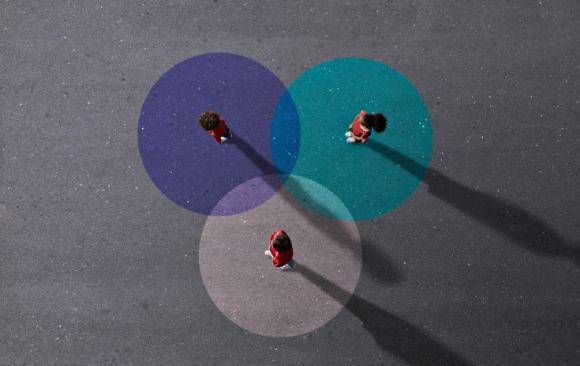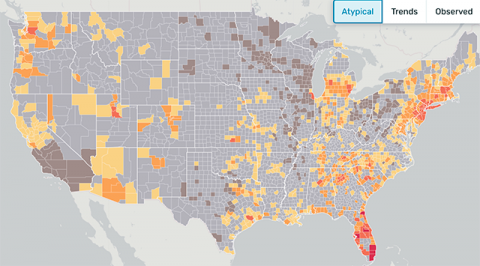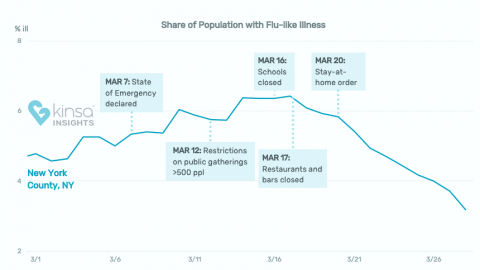


According to the World Health Organization and the CDC, social distancing is currently the most effective way to slow the spread of COVID-19. The Centers for Disease Control and Prevention describes social distancing as staying away from mass gatherings and keeping a distance of 6 feet, about one body length, away from other people. Social distancing also means not touching other people, and that includes handshakes. Physical touch is the most likely way a person will catch the coronavirus and the easiest way to spread it.
Social distancing can never prevent 100% of transmissions, but by following these simple rules, individuals are playing a critical role in slowing the spread of the coronavirus. If the number of cases isn’t kept below what the health care system can handle at any one time – called flattening the curve – hospitals could become overwhelmed, leading to unnecessary deaths and suffering.
Staying home and limiting contact with others is absolutely helping, according to Governor Andrew Cuomo, health experts and research data. Cuomo made it clear, socially distancing must continue in order to limit the peak of COVID-19. “New York is plateauing, because social distancing is working, so we need to continue that,” Gov. Cuomo said Monday. “Schools and non-essential businesses will remain closed until April 29.” Fines will be doubled for those who don’t comply with social distancing rules.
There have been 4,758 COVID-19 deaths in New York State, and there are 130,689 confirmed cases. New York City remains the epicenter of the COVID-19 crisis in the state and that is why Governor Andrew Cuomo has extended NY PAUSE through the remainder of April.
NYC Health Department has collected data about people who have tested positive for COVID-19 here in the city:
| Cases: | 74,601 |
| Total hospitalized*: | 19,177 |
| Deaths: | 3,544 |
As of 4/7/2020 at 5pm DOHMH continues to update this info at this link. They are discouraging people with mild to moderate symptoms from being tested at this time, so the data primarily represent people with more severe illness.
Georges Benjamin, executive director of the American Public Health Association, said "It is clear that social distancing measures are working." There are hopeful signs that social distancing is slowing the spread of influenza, and quite possibly COVID-19 as well. This data released last week by Kinsa Health, medical technology company, suggests that fevers — a common symptom of COVID-19 — are decreasing in areas where stay-at-home orders are in place and being followed. This implies that yes, it's helping. See full size map and zoom into NY. Benjamin said, "Data tracking using temperatures themselves, and then self-reported symptoms are two tools that have gone way beyond proof of concept and will help us do disease surveillance for infectious diseases in the future, for sure, and possibly for chronic diseases as well.”

The map created by Kinsa Health, which produces internet-connected thermometers and data from the health departments of New York State make it clear that social distancing is saving lives and is, in fact, slowing the spread of COVID-19.
Maps of fever readings from across the country seem to indicate that strict social distancing measures may be helping reduce cases of the novel coronavirus. Kinsa Health has been collecting at least 162,000 daily temperature readings. The firm can't track the spread of the virus specifically, because it looks only at fevers tied to geographic data, for those using the thermometers. Prior to using the tool to track COVID-19, it has mostly been used to track where seasonal flu outbreaks are occurring.
The map above shows you how much influenza-like illness above the normal expected levels we have detected since March 1. Social distancing is slowing the spread of feverish illnesses across the country. See the data here.

New York City was one of the first to enact aggressive social distancing measures in order to combat the spread of COVID-19. You can see in the infographic how these early and aggressive measures helped to flatten the curve of atypical illness. This does not mean that COVID-19 cases are declining. This data indicates these measures are starting to slow the spread. Overall, Governor Cuomo is urging people to stay home as much as possible and to keep a safe distance of 6 feet from others in public spaces to reduce the spread of Coronavirus.